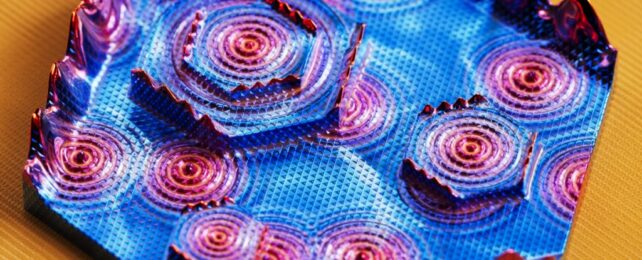Physicists have just found something no one expected, lurking on the surface of an arsenic crystal.
While undertaking a study of quantum topology – the wave-like behavior of particles combined with the mathematics of geometry – a team found a strange hybrid of two quantum states, each describing a different means of current.
"This finding was completely unexpected," says physicist M. Zahid Hasan of Princeton University. "Nobody predicted it in theory before its observation."
Topology is becoming increasingly important in understanding the behavior of materials that can only be described by ther wave-like properties, known as quantum matter. Concerned with the geometry of structures that don't effectively change when bent or warped (but might if they are broken or pierced), topology has the potential to affect the quantum activity of materials in a variety of ways.
A lot of that research involves compounds with a base of bismuth, since bismuth is an efficient topological insulator – a material whose outer layer acts as a conductor of activity, and interior acts as an insulator. That means the electrons inside are immobile, but those on the surface and edges can move around freely.
Commonly used in semiconducting materials, arsenic can also behave as a topological insulator. Physicists, including Hasan and his team, have been looking for new quantum states in topological insulators, particularly those that can operate at room temperature.
Bismuth-based materials have provided many insights, but they require high temperatures and are complicated to synthesize and prepare. Arsenic, by contrast, can be grown in a form that is cleaner than bismuth, and is simpler to prepare. So the researchers grew crystals of gray arsenic, which has a metallic appearance, and applied magnetic fields.
Then, they probed the sample using scanning tunneling microscopy (STM), which produces images at subatomic scales, and photoemission spectroscopy, which measured the energy states of electrons.
They found surface states – electron states that flow along 'gapless' surfaces of some kinds of topological insulator – which was fine and normal. But no one expected what else they found – edge states that exist on the boundaries of a completely different kind of topological insulator, and have never before been seen side-by-side with surface states.
"We were surprised," says physicist Md. Shafayat Hossain of Princeton University. "Gray arsenic was supposed to have only surface states. But when we examined the atomic step edges, we also found beautiful conducting edge modes."
They could only conclude that what they were observing was a hybrid state that no one has ever seen before.
"Typically, we consider the bulk band structure of a material to fall into one of several distinct topological classes, each tied to a specific type of boundary state," says physicist David Hsieh of Caltech, who was not involved in the research.
"This work shows that certain materials can simultaneously fall into two classes. Most interestingly, the boundary states emerging from these two topologies can interact and reconstruct into a new quantum state that is more than just a superposition of its parts."
The discovery could unlock a new kind of quantum materials, which in turn could advance quantum physics research, as well as technologies such as quantum computing.
"We envision that arsenic, with its unique topology, can serve as a new platform at a similar level for developing novel topological materials and quantum devices that are not currently accessible through existing platforms," Hasan says.
"A new exciting frontier in material science and novel physics awaits!"
The research has been published in Nature.
